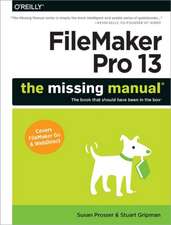FileMaker Pro 12: The Missing Manual
Autor Susan Prosser, Stuart Gripmanen Limba Engleză Paperback – 9 aug 2012
The important stuff you need to know:
- Get started. Tour FileMaker Pro's features and create your first database in minutes.
- Catalog your data. View, sort, and shape information in dozens of ways.
- Create professional documents. Publish reports, invoices, and other documents with ease.
- Harness processing power. Use calculations and scripts to crunch numbers, search text, and automate tasks.
- Add visual power and clarity. Create colorful charts to illustrate and summarize your data.
- Think like a developer. Dive into the high-level features of FileMaker Pro Advanced.
Preț: 252.47 lei
Preț vechi: 315.59 lei
-20% Nou
Puncte Express: 379
Preț estimativ în valută:
48.31€ • 50.67$ • 40.22£
48.31€ • 50.67$ • 40.22£
Carte disponibilă
Livrare economică 11-25 martie
Preluare comenzi: 021 569.72.76
Specificații
ISBN-13: 9781449316280
ISBN-10: 144931628X
Pagini: 960
Ilustrații: Illustrations
Dimensiuni: 171 x 251 x 49 mm
Greutate: 1.33 kg
Editura: O'Reilly
ISBN-10: 144931628X
Pagini: 960
Ilustrații: Illustrations
Dimensiuni: 171 x 251 x 49 mm
Greutate: 1.33 kg
Editura: O'Reilly
Cuprins
The Missing Credits;
About the Authors;
About the Creative Team;
Acknowledgments;
The Missing Manual Series;
Introduction;
Why FileMaker Pro?;
About This Book;
Macintosh and Windows;
About the Outline;
What's New in FileMaker Pro 12;
The Very Basics;
About Online Resources;
Safari® Books Online;
Part 1: Getting Started with FileMaker;
Chapter 1: Working with a Database;
1.1 A Very Quick Database Tour;
1.2 Opening and Closing Database Files;
1.3 Adding Data to Your Database;
1.4 Navigating Your Database;
1.5 Finding Records;
1.6 Sorting Records;
1.7 Same Database, Different Views;
1.8 Saving Your Database;
1.9 Using FileMaker's Help Menu;
Chapter 2: Organizing and Editing Records;
2.1 Views;
2.2 Advanced Find Techniques;
2.3 Editing What's in Your Fields;
2.4 Changing Text Appearance;
2.5 Checking Spelling;
2.6 Preview Mode and Printing;
Part 2: Building Your First Database;
Chapter 3: Creating a Custom Database;
3.1 Creating a New Database;
3.2 Creating and Managing Fields in Table View;
3.3 Understanding Layouts;
3.4 Customizing a Layout;
3.5 Creating a New Layout;
3.6 Arrange and Align Tools;
Chapter 4: Adding Power to Your Database;
4.1 Creating a Simple Calculation;
4.2 Creating a Related Table;
4.3 Creating and Using Portals;
4.4 Using Tab Controls;
4.5 Adding Merge Fields;
4.6 Writing a Basic Script;
4.7 Creating a Dynamic Report with the Assistant;
4.8 Creating a Trailing Group Report;
4.9 Creating Charts in Table View;
4.10 Changing the Default Account;
4.11 Summing Up;
Part 3: Thinking Like a Developer;
Chapter 5: Creating and Managing a Relational Database;
5.1 Understanding Relational Databases;
5.2 Modeling Your Database;
5.3 Creating a Relational Database;
5.4 Using Relational Database Power;
5.5 Lookups;
5.6 Reviewing Relationship Concepts;
Chapter 6: Field Options;
6.1 Understanding Field Types;
6.2 Auto-Enter Field Options;
6.3 Validation Options;
6.4 Storage Options;
6.5 Beyond Text: Container Fields;
Chapter 7: Layout Mechanics;
7.1 Layout Types;
7.2 Layout Parts;
7.3 Formatting Fields;
7.4 Advanced Field Controls;
7.5 Tab Order;
7.6 Creating Layouts for Printing;
Chapter 8: Layout Design;
8.1 Layout Themes;
8.2 Touch Themes;
8.3 Grids, Guides, and Dynamic Guides;
8.4 Screen Stencils;
8.5 Data Formatting;
8.6 Merge Fields;
8.7 Merge Variables;
8.8 Tooltips;
8.9 Autosizing;
8.10 Buttons;
Chapter 9: Understanding Calculations;
9.1 Understanding Calculations;
9.2 Using a Related Field in a Calculation;
9.3 Understanding the Specify Calculation Dialog Box;
9.4 Auto-Enter Calculations;
9.5 Validate Data Entry with a Calculation;
9.6 Commenting in Calculations;
Chapter 10: More Calculations and Data Types;
10.1 Number Crunching Calculations;
10.2 Going Beyond Basic Calculations;
10.3 Text Calculations;
10.4 Date and Time Calculations;
10.5 Containers in Calculations;
Chapter 11: Understanding Scripts;
11.1 Understanding Scripts;
11.2 Your First Script;
11.3 Shortcuts to the Edit Script Window;
11.4 The Importance of the Layout;
11.5 Running Scripts;
11.6 Organizing Your Scripts;
11.7 Branching and Looping in Scripts;
11.8 Script Triggers;
Chapter 12: Exploring Script Steps;
12.1 Go to Layout;
12.2 Go to Object;
12.3 Scripting for Fields;
12.4 Working with Records;
12.5 Finding Records;
12.6 Sorting Records;
12.7 Working with Windows;
12.8 Working with Files;
12.9 Printing;
12.10 Other Script Steps;
Part 4: Becoming a Power Developer;
Chapter 13: Applying Developer Utilities;
13.1 Copying and Pasting Database Structure;
13.2 Script Debugger;
13.3 The Data Viewer;
13.4 Disable Script Steps;
13.5 The Database Design Report;
13.6 Custom Functions;
13.7 Custom Menus;
13.8 Developer Utilities;
13.9 File Maintenance;
Chapter 14: Advanced Relationship Techniques;
14.1 Advanced Relationships;
14.2 Portal Filtering;
14.3 Understanding Table Occurrences;
14.4 Table Occurrence Groups;
14.5 Understanding Graph Arrangements;
14.6 Connecting Database Files;
14.7 Using Multiple Relationship Techniques;
Chapter 15: Reporting and Analysis;
15.1 Summary Fields and Subsummary Parts;
15.2 Web Viewer Objects;
15.3 Conditional Formatting;
15.4 Basic Charting (Found Set Charts);
15.5 Chart Formatting;
15.6 Charting and Reports;
15.7 Advanced Charting;
Chapter 16: Advanced Calculations;
16.1 Understanding Boolean Functions;
16.2 Using Storage Options;
16.3 Logical Functions;
16.4 The Let() Function and Variables;
16.5 Recursion;
16.6 Plug-Ins;
Chapter 17: Advanced Scripting;
17.1 Commenting Scripts;
17.2 Importing Scripts;
17.3 Communicating with Database Users;
17.4 Creating Modular Scripts;
17.5 Script Parameters;
17.6 Script Variables;
17.7 Handling Errors;
17.8 Advanced Script Triggers;
17.9 Putting a Complex Script Together;
Part 5: Security and Integration;
Chapter 18: Sharing Your Database;
18.1 FileMaker Network Sharing;
18.2 Sharing Over the Internet;
18.3 FileMaker Server;
18.4 Server Hardware;
18.5 FileMaker Go;
Chapter 19: Adding Security;
19.1 How Security Works;
19.2 Privilege Sets;
19.3 Managing Accounts;
19.4 Extended Privileges;
19.5 Managing External File Access;
19.6 Scripts and Security;
Chapter 20: Sharing Data with Other Systems;
20.1 Sharing Your Data with Others;
20.2 Snapshot Link;
20.3 External SQL Sources;
20.4 Exporting Data;
20.5 Importing Data;
20.6 Import Data Sources;
20.7 Importing and Exporting in a Script;
Part 6: Appendixes;
Getting Help;
Getting Help from FileMaker Pro;
FileMaker's Installed Extras;
Getting Help from the Community;
File Conversion;
Compatibility;
Understanding Conversion;
Start with a Test Run;
Converting a Single File;
Converting Multiple Files;
Using the Insert Commands with Container Fields;
FileMaker Error Codes;
About the Authors;
About the Creative Team;
Acknowledgments;
The Missing Manual Series;
Introduction;
Why FileMaker Pro?;
About This Book;
Macintosh and Windows;
About the Outline;
What's New in FileMaker Pro 12;
The Very Basics;
About Online Resources;
Safari® Books Online;
Part 1: Getting Started with FileMaker;
Chapter 1: Working with a Database;
1.1 A Very Quick Database Tour;
1.2 Opening and Closing Database Files;
1.3 Adding Data to Your Database;
1.4 Navigating Your Database;
1.5 Finding Records;
1.6 Sorting Records;
1.7 Same Database, Different Views;
1.8 Saving Your Database;
1.9 Using FileMaker's Help Menu;
Chapter 2: Organizing and Editing Records;
2.1 Views;
2.2 Advanced Find Techniques;
2.3 Editing What's in Your Fields;
2.4 Changing Text Appearance;
2.5 Checking Spelling;
2.6 Preview Mode and Printing;
Part 2: Building Your First Database;
Chapter 3: Creating a Custom Database;
3.1 Creating a New Database;
3.2 Creating and Managing Fields in Table View;
3.3 Understanding Layouts;
3.4 Customizing a Layout;
3.5 Creating a New Layout;
3.6 Arrange and Align Tools;
Chapter 4: Adding Power to Your Database;
4.1 Creating a Simple Calculation;
4.2 Creating a Related Table;
4.3 Creating and Using Portals;
4.4 Using Tab Controls;
4.5 Adding Merge Fields;
4.6 Writing a Basic Script;
4.7 Creating a Dynamic Report with the Assistant;
4.8 Creating a Trailing Group Report;
4.9 Creating Charts in Table View;
4.10 Changing the Default Account;
4.11 Summing Up;
Part 3: Thinking Like a Developer;
Chapter 5: Creating and Managing a Relational Database;
5.1 Understanding Relational Databases;
5.2 Modeling Your Database;
5.3 Creating a Relational Database;
5.4 Using Relational Database Power;
5.5 Lookups;
5.6 Reviewing Relationship Concepts;
Chapter 6: Field Options;
6.1 Understanding Field Types;
6.2 Auto-Enter Field Options;
6.3 Validation Options;
6.4 Storage Options;
6.5 Beyond Text: Container Fields;
Chapter 7: Layout Mechanics;
7.1 Layout Types;
7.2 Layout Parts;
7.3 Formatting Fields;
7.4 Advanced Field Controls;
7.5 Tab Order;
7.6 Creating Layouts for Printing;
Chapter 8: Layout Design;
8.1 Layout Themes;
8.2 Touch Themes;
8.3 Grids, Guides, and Dynamic Guides;
8.4 Screen Stencils;
8.5 Data Formatting;
8.6 Merge Fields;
8.7 Merge Variables;
8.8 Tooltips;
8.9 Autosizing;
8.10 Buttons;
Chapter 9: Understanding Calculations;
9.1 Understanding Calculations;
9.2 Using a Related Field in a Calculation;
9.3 Understanding the Specify Calculation Dialog Box;
9.4 Auto-Enter Calculations;
9.5 Validate Data Entry with a Calculation;
9.6 Commenting in Calculations;
Chapter 10: More Calculations and Data Types;
10.1 Number Crunching Calculations;
10.2 Going Beyond Basic Calculations;
10.3 Text Calculations;
10.4 Date and Time Calculations;
10.5 Containers in Calculations;
Chapter 11: Understanding Scripts;
11.1 Understanding Scripts;
11.2 Your First Script;
11.3 Shortcuts to the Edit Script Window;
11.4 The Importance of the Layout;
11.5 Running Scripts;
11.6 Organizing Your Scripts;
11.7 Branching and Looping in Scripts;
11.8 Script Triggers;
Chapter 12: Exploring Script Steps;
12.1 Go to Layout;
12.2 Go to Object;
12.3 Scripting for Fields;
12.4 Working with Records;
12.5 Finding Records;
12.6 Sorting Records;
12.7 Working with Windows;
12.8 Working with Files;
12.9 Printing;
12.10 Other Script Steps;
Part 4: Becoming a Power Developer;
Chapter 13: Applying Developer Utilities;
13.1 Copying and Pasting Database Structure;
13.2 Script Debugger;
13.3 The Data Viewer;
13.4 Disable Script Steps;
13.5 The Database Design Report;
13.6 Custom Functions;
13.7 Custom Menus;
13.8 Developer Utilities;
13.9 File Maintenance;
Chapter 14: Advanced Relationship Techniques;
14.1 Advanced Relationships;
14.2 Portal Filtering;
14.3 Understanding Table Occurrences;
14.4 Table Occurrence Groups;
14.5 Understanding Graph Arrangements;
14.6 Connecting Database Files;
14.7 Using Multiple Relationship Techniques;
Chapter 15: Reporting and Analysis;
15.1 Summary Fields and Subsummary Parts;
15.2 Web Viewer Objects;
15.3 Conditional Formatting;
15.4 Basic Charting (Found Set Charts);
15.5 Chart Formatting;
15.6 Charting and Reports;
15.7 Advanced Charting;
Chapter 16: Advanced Calculations;
16.1 Understanding Boolean Functions;
16.2 Using Storage Options;
16.3 Logical Functions;
16.4 The Let() Function and Variables;
16.5 Recursion;
16.6 Plug-Ins;
Chapter 17: Advanced Scripting;
17.1 Commenting Scripts;
17.2 Importing Scripts;
17.3 Communicating with Database Users;
17.4 Creating Modular Scripts;
17.5 Script Parameters;
17.6 Script Variables;
17.7 Handling Errors;
17.8 Advanced Script Triggers;
17.9 Putting a Complex Script Together;
Part 5: Security and Integration;
Chapter 18: Sharing Your Database;
18.1 FileMaker Network Sharing;
18.2 Sharing Over the Internet;
18.3 FileMaker Server;
18.4 Server Hardware;
18.5 FileMaker Go;
Chapter 19: Adding Security;
19.1 How Security Works;
19.2 Privilege Sets;
19.3 Managing Accounts;
19.4 Extended Privileges;
19.5 Managing External File Access;
19.6 Scripts and Security;
Chapter 20: Sharing Data with Other Systems;
20.1 Sharing Your Data with Others;
20.2 Snapshot Link;
20.3 External SQL Sources;
20.4 Exporting Data;
20.5 Importing Data;
20.6 Import Data Sources;
20.7 Importing and Exporting in a Script;
Part 6: Appendixes;
Getting Help;
Getting Help from FileMaker Pro;
FileMaker's Installed Extras;
Getting Help from the Community;
File Conversion;
Compatibility;
Understanding Conversion;
Start with a Test Run;
Converting a Single File;
Converting Multiple Files;
Using the Insert Commands with Container Fields;
FileMaker Error Codes;
Notă biografică
Descriere
FileMaker Pro 12: The Missing Manual is the clear, thorough, and accessible guide to the latest version of this popular desktop database program. This book shows you how use FileMaker to make information work for you -- print a catalog, plan your retirement, or run a small business.





















